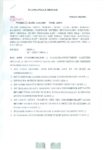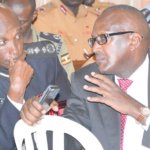In 2005 President Yoweri Museveni appointed then Major General Edward Kale Kayihura, the Inspector General of Police. Following that appointment Gen Kayihura became only the second soldier to serve as IGP under the National Resistance Movement (NRM) government, after having taken over from then Major General Edward Katumba Wamala.
The IGP is appointed to serve a three-year term and so far Gen Kayihura is serving his fourth term, supposed to end in November this year. It is not clear if Mr Museveni will re-appoint him to the top police office but some sources suggest he might name another person, and fingers are pointing to Brigadier Leopold Kyanda, the current Chief of Staff Land Forces.
Reports about Gen Kayihura’s replacement as IGP come at a time when some senior police officers are reportedly disgruntled, with some even petitioning the Inspector General of Government (IGG) over the recent promotions, in which over 400 officers were promoted, while lawyers in the force have also gone to court to sue the Force over salary disparities.
However, any changes that might be made may affect the General substantially, as reports indicate that he ‘replaced’ former Prime Minister John Amama Mbabazi as the President’s most trusted confidant. Which begs the question: if replaced, will Gen Kayihura’s status quo be maintained?
But that notwithstanding, from the onset Gen Kayihura’s period in office while at the helm of the police was not going to be simple razzmatazz, mostly during electioneering periods in between 2005/6, 2010/11 and most recently in 2015/16.
For instance in 2005 he had to engage opposition figure Col Dr Kizza Besigye, who was then returning from exile in South Africa to vie for the presidency, contesting against (Dr Besigye) former Commander-in-Chief Yoweri Museveni. Besigye’s return was momentous, with frenzied crowds swarming the streets of Kampala to show him support. Then, as if on cue, police had to react, using tear gas for the first time to quell politically riotous Ugandans. It was not fun; and for Gen Kayihura that was a baptism of fire of sorts.
It should be recounted that before the re-introduction of multi-party politics in Uganda, the job of IGP was to generally supervise an otherwise subtle force dealing mostly with non-political matters. But this was to change drastically when a re-energised opposition under Besigye and other political actors like Norbert Mao. Gen Kayihura sprung.
A lawyer and academic, Gen Kayihura has both admirers and critics, with the latter saying he has militarized the police, an otherwise erstwhile civil force. But his admirers including the appointing authority President Museveni, have lauded him for a ‘job well done’ and the man from Kisoro is now a full four-star General, rising from the rank of Major in 1987 when the then National Resistance Army (NRA) regularized ranks.
But during his military career that now spans 34 years, there is no single time Gen Kayihura has come under scrutiny than when he has held the office of the IGP, now in the 11th year.
According to his admirers, Gen Kayihura has spearheaded reforms in the police, giving the force ‘visibility’. He has also made sure the budget is raised, and currently stands at about 700 billion Shillings annually. This money, the admirers argue, has helped police increase its fleet, build infrastructure like the police Headquarters and upcountry stations, and also improve on the image of police, including hiring of educated personnel and the promotion of women in the Force.
“Despite the cases of criticism against the police, the IGP has acquitted himself well in areas like welfare of officers, infrastructure development and training of personnel and gender parity,” says one of his admirers.
But critics say the improved budget has instead gone to buy tools of repression including among others armoured cars, new guns and tear gas. They also say not much has been done by way of infrastructure development including housing, while pointing to the dilapidated barracks around Kampala like Naguru and Nsambya plus more in up-country towns.
In fact some even questioned his discretion when the police recently acquired over 20 Toyota Land Cruiser and Prado 4X4s for the Uganda Police Force (UPF) top officers and three choppers, all estimated at several hundred billions of shillings, when the juniors are sleeping in ‘mama ingia pole’, some ramshackle structure that they deem not fit for human habitation.
But it is the political protests, quelled by a not-so-civil police, at times using live bullets against unarmed civilians and randomly tossing tear gas canisters, that will most likely hound and define gen Kayihura’s legacy. After all Ugandans even coined a moniker for him: Afande Teargas.
Another area where Gen Kayihura has come under scrutiny is his handling of Dr Kizza Besigye, mostly this time round, during the electioneering process for the 2016 presidential elections.
Further, Gen Kayihura will be remembered as the one man who has ‘tormented’ the opposition to the Museveni presidency, mostly against Dr Kizza Besigye, a leading contender for the office of the President in all the four elections held since 2001.
But Gen Kayihura’s worst moment is the 2016 elections, in which the police seemed to curtail most Dr Besigye’s freedoms: from pre-election arrests to post-election restricted movement, bordering on house arrest.
It is against such background then that some opposition personalities have even threatened, to drag Gen Kayihura to the International Criminal Court (ICC) in The Hague.
It is not clear if the opposition will be able to pull through with this threat but if they do, (or have they already done so?) he will again become only the second police chief in East Africa to face indictment after Major General Mohamed Ali of Kenya, who was indicted for the post-election violence in Kenya following the 2007 general elections.








